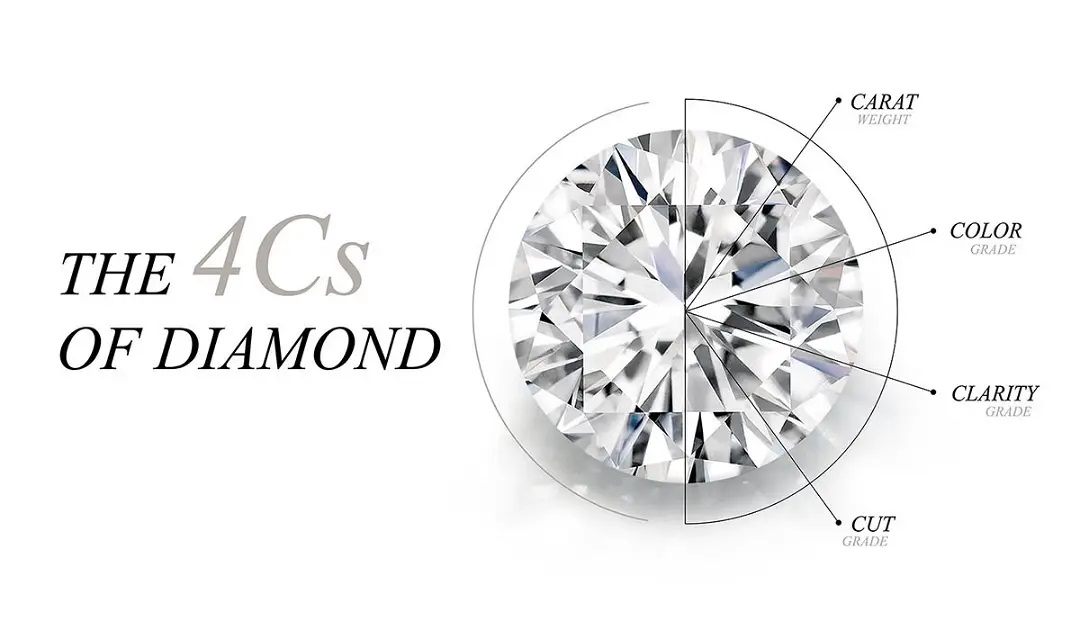Diamond 4Cs | All You Need to Know About the 4 Cs
In the dazzling world of diamonds, understanding the 4Cs—Carat, Cut, Color, and Clarity—is not just a matter of technicalities; it is the cornerstone of informed decision-making. Whether you’re an enthusiast, a prospective buyer, or a seasoned industry professional, a comprehensive grasp of the 4Cs is essential. In this article, we delve into the reasons behind the importance of the 4Cs, why you need to know about them, the features that matter most, and an exploration of the inclusions that can occur in these precious gems.
Why the 4Cs?

The 4Cs serve as a universal language in the diamond industry, providing a standardized framework for evaluating and communicating the quality of diamonds. Developed by the Gemological Institute of America (GIA), the 4Cs offer a comprehensive and objective way to assess diamonds, ensuring that consumers and industry professionals alike can make informed comparisons and decisions. Let’s break down each of the 4Cs and explore their significance:
- Carat:
- Carat weight is a fundamental factor influencing a diamond’s value.
- Larger diamonds are generally more valuable, but carat weight alone does not determine a diamond’s overall quality.
- Cut:
- The cut of a diamond impacts its brilliance and visual appeal.
- A well-cut diamond reflects light internally, creating a captivating sparkle.
- The cut also considers proportions, symmetry, and finish.
- Color:
- Diamond color is graded on a scale from D (colorless) to Z (light yellow or brown).
- The less color a diamond exhibits, the higher its grade and value.
- Even subtle color differences can impact a diamond’s beauty.
- Clarity:
- Clarity assesses the presence of inclusions (internal flaws) and blemishes (external flaws).
- A higher clarity grade indicates fewer imperfections.
- Clarity is essential for understanding a diamond’s purity and rarity.
Why You Need to Know About the Four C’s
Understanding the Four C’s of diamonds—Carat, Cut, Color, and Clarity—is essential for anyone navigating the world of diamonds, whether you’re a prospective buyer, a jewelry enthusiast, or a seasoned industry professional. Here are compelling reasons why you need to know about the Four C’s:

- Informed Decision-Making:
- Knowledge of the Four C’s empowers you to make informed decisions when purchasing diamonds. Whether you’re selecting a diamond for an engagement ring, other jewelry, or investment, understanding these criteria allows you to prioritize features that align with your preferences and values.
- Value Assessment:
- The Four C’s are the universal standard for evaluating a diamond’s quality. Knowing how each factor contributes to a diamond’s value helps you assess the price you are willing to pay. This knowledge ensures that you get the best value for your investment.
- Customization and Personalization:
- Each diamond is unique, and the Four C’s provide a framework for customizing your choice. Whether you prioritize a larger carat size, a specific cut for maximum brilliance, a certain color grade, or impeccable clarity, understanding the Four C’s allows you to tailor your diamond selection to your individual preferences.
- Quality Comparison:
- The Four C’s facilitate objective comparisons between different diamonds. This is crucial, especially when choosing between stones with varying characteristics. By understanding these criteria, you can evaluate diamonds side by side and select the one that best meets your requirements.
- Appreciation of Beauty:
- Knowledge of the Four C’s enhances your appreciation of a diamond’s beauty. Understanding how cut influences brilliance, how color affects the gem’s appearance, and how clarity contributes to purity allows you to see beyond the surface and recognize the unique qualities that make each diamond special.
- Confidence in Purchase:
- When armed with knowledge about the Four C’s, you approach the diamond-buying process with confidence. Whether dealing with a jeweler or making an online purchase, your understanding of these criteria ensures that you can communicate your preferences effectively and make decisions that align with your expectations.
- Avoiding Common Pitfalls:
- Without knowledge of the Four C’s, buyers may fall prey to common misconceptions or marketing strategies. Understanding these criteria safeguards you against overpaying for certain features or unknowingly sacrificing quality in one aspect for another.
- Communication with Jewelers:
- When working with jewelers or industry professionals, knowing the Four C’s allows for effective communication. You can articulate your preferences, ask pertinent questions, and engage in discussions about the specific qualities you seek in a diamond.
Which Features Matter Most?
- Personal Preferences:
- The features that matter most depend on individual preferences.
- Some may prioritize a larger carat size, while others may focus on a brilliant cut or exceptional clarity.
- Balancing the 4Cs:
- Achieving the perfect balance of the 4Cs is an art.
- A well-cut diamond with balanced color and clarity can maximize its overall beauty and value.
What Kind of Inclusions Can Occur?
Diamonds, despite their extraordinary beauty, often contain natural imperfections known as inclusions and blemishes. These characteristics are collectively referred to as “clarity characteristics.” Understanding the types of inclusions that can occur in diamonds is crucial for assessing their clarity grade. Here are some common inclusions:
- Internal Inclusions:
- Crystals: Tiny minerals or crystals within the diamond are common inclusions. These can be minerals like garnet or other diamond crystals.
- Feathers: Small fractures that resemble feathers are a prevalent type of inclusion. The size and location of feathers influence the diamond’s clarity grade.
- External Blemishes:
- Scratches: Surface scratches on the diamond are considered blemishes. These can occur during the cutting and polishing process or through wear over time.
- Nicks: Small notches on the diamond’s surface are known as nicks and can affect the overall clarity.
- Internal Clouds:
- Clouds: Clusters of tiny pinpoints or crystals that create a hazy or cloudy appearance within the diamond are referred to as clouds. Their size, density, and visibility impact the diamond’s clarity grade.
Conclusion
In the world of diamonds, the 4Cs are not merely a set of criteria; they are the key to unlocking the beauty, value, and uniqueness of each gem. Knowing why the 4Cs matter, understanding their significance, and appreciating the balance between these factors empower individuals to make choices that align with their preferences and values. Whether you’re on the quest for the perfect engagement ring or simply intrigued by the allure of diamonds, the journey begins with a deep understanding of the 4Cs—your guide to the world of exquisite brilliance and timeless beauty.…

